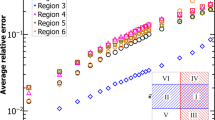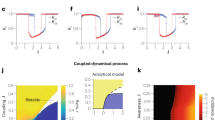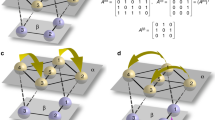Abstract
We investigate how the structure of interactions between coupled oscillators influences the formation of asynchronous patterns in a multilayer network by formulating a simple, general multilayer oscillator model. We demonstrate the analysis of this model in three-oscillator systems, illustrating the role of interactions among oscillators in sustaining differences in both the phase and amplitude of oscillations leading to the formation of asynchronous patterns. Finally, we demonstrate the generalizability of our model’s predictions through comparison with a more realistic multilayer model. Overall, our model provides a useful approach for predicting the types of asynchronous patterns that multilayer networks of coupled oscillators which cannot be achieved by the existing methods which focus on characterizing the synchronous state.


Similar content being viewed by others
References
Aguiar MA, Dias APS (2014) The lattice of synchrony subspaces of a coupled cell network: characterization and computation algorithm. J Nonlinear Sci 24(6):949–996
Albert R, Barabási AL (2002) Statistical mechanics of complex networks. Rev Mod Phys 74(1):47
Arenas A, Díaz-Guilera A, Kurths J, Moreno Y, Zhou C (2008) Synchronization in complex networks. Phys Rep 469(3):93–153
Asllani M, Busiello DM, Carletti T, Fanelli D, Planchon G (2014) Turing patterns in multiplex networks. Phys Rev E 90(4):042814
Barahona M, Pecora LM (2002) Synchronization in small-world systems. Phys Rev Lett 89(5):054101
Boccaletti S, Latora V, Moreno Y, Chavez M, Hwang DU (2006) Complex networks: structure and dynamics. Phys Rep 424(4):175–308
Boccaletti S, Bianconi G, Criado R, Del Genio CI, Gómez-Gardenes J, Romance M, Sendina-Nadal I, Wang Z, Zanin M (2014) The structure and dynamics of multilayer networks. Phys Rep 544(1):1–122
Brechtel A, Gramlich P, Ritterskamp D, Drossel B, Gross T (2018) Master stability functions reveal diffusion-driven pattern formation in networks. Phys Rev E 97(3):032307
Cross MC, Hohenberg PC (1993) Pattern formation outside of equilibrium. Rev Mod Phys 65(3):851
Díaz-Guilera A, Arenas A (2008) Phase patterns of coupled oscillators with application to wireless communication. In: Bio-inspired computing and communication. Springer, pp 184–191
Do AL, Höfener J, Gross T (2012) Engineering mesoscale structures with distinct dynamical implications. New J Phys 14(11):115022
Faloutsos M, Faloutsos P, Faloutsos C (1999) On power-law relationships of the internet topology. In: ACM SIGCOMM computer communication review, vol 29. ACM, pp 251–262
Freeman LC (1996) Some antecedents of social network analysis. Connections 19(1):39–42
Goldwyn EE, Hastings A (2008) When can dispersal synchronize populations? Theor Popul Biol 73(3):395–402
Hata S, Nakao H, Mikhailov AS (2014) Dispersal-induced destabilization of metapopulations and oscillatory turing patterns in ecological networks. Sci Rep 4:3585
Hayes SM, Anderson KE (2018) Beyond connectivity: how the structure of dispersal influences metacommunity dynamics. Theor Ecol 11(2):151–159
Holland MD, Hastings A (2008) Strong effect of dispersal network structure on ecological dynamics. Nature 456(7223):792–794
Holyoak M, Fahrig L (2000) Habitat patch arrangement and metapopulation persistence of predators and prey. Am Nat 156(4):378–389
Jeong H, Tombor B, Albert R, Oltvai ZN, Barabási AL (2000) The large-scale organization of metabolic networks. Nature 407(6804):651–654
Kamei H, Cock PJ (2013) Computation of balanced equivalence relations and their lattice for a coupled cell network. SIAM J Appl Dyn Syst 12(1):352–382
Kouvaris NE, Hata S, Díaz-Guilera A (2015) Pattern formation in multiplex networks. Sci Rep 5:10840
Kuramoto Y (1975) Self-entrainment of a population of coupled non-linear oscillators. In: International symposium on mathematical problems in theoretical physics. Springer, pp 420–422
Nakao H, Mikhailov AS (2010) Turing patterns in network-organized activator-inhibitor systems. Nat Phys 6(7):544–550
Pecora LM, Carroll TL (1998) Master stability functions for synchronized coupled systems. Phys Rev Lett 80(10):2109
Rosenzweig ML, MacArthur RH (1963) Graphical representation and stability conditions of predator–prey interactions. Am Nat 97:209–223
Sachtjen M, Carreras B, Lynch V (2000) Disturbances in a power transmission system. Phys Rev E 61(5):4877
Stewart I, Golubitsky M, Pivato M (2003) Symmetry groupoids and patterns of synchrony in coupled cell networks. SIAM J Appl Dyn Syst 2(4):609–646
Strogatz SH (2000) From kuramoto to crawford: exploring the onset of synchronization in populations of coupled oscillators. Physica D 143(1):1–20
Strogatz SH (2001) Exploring complex networks. Nature 410(6825):268–276
Turing AM (1952) The chemical basis of morphogenesis. Philos Trans R Soc Lond B Biol Sci 237(641):37–72
Uhlhaas PJ, Roux F, Rodriguez E, Rotarska-Jagiela A, Singer W (2010) Neural synchrony and the development of cortical networks. Trends Cognit Sci 14(2):72–80
Varela F, Lachaux JP, Rodriguez E, Martinerie J (2001) The brainweb: phase synchronization and large-scale integration. Nat Rev Neurosci 2(4):229–239
Watts DJ, Strogatz SH (1998) Collective dynamics of ‘small-world’ networks. Nature 393(6684):440–442
Wolfrum M (2012) The turing bifurcation in network systems: collective patterns and single differentiated nodes. Physica D 241(16):1351–1357
Acknowledgements
Kurt E. Anderson was supported in part by NSF DEB 1553718.
Author information
Authors and Affiliations
Corresponding author
Additional information
Publisher's Note
Springer Nature remains neutral with regard to jurisdictional claims in published maps and institutional affiliations.
Rights and permissions
About this article
Cite this article
Hayes, S.M., Anderson, K.E. Predicting Pattern Formation in Multilayer Networks. Bull Math Biol 82, 4 (2020). https://doi.org/10.1007/s11538-019-00682-1
Received:
Accepted:
Published:
DOI: https://doi.org/10.1007/s11538-019-00682-1




